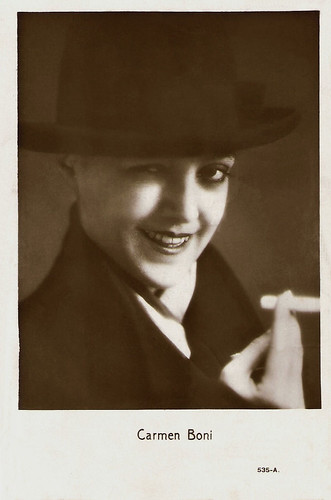
Italian postcard by G.B. Falci Editore, Milano, no. 535-A.

Italian postcard by G.B. Falci, Milano, no. 51. Photo: Fotominio. Maria Jacobini, Carmen Boni and Maria Moreno in the Italian silent film La preda/The Prey (Gugielmo Zorzi, 1921).

Italian postcard by Ed. G.B. Falci, Milano, no. 698. Photo: Films Genina. Carmen Boni in Addio giovinezza/Goodbye Youth (Augusto Genina, 1927).

Italian postcard by Ed. G.B. Falci, Milano, no. 772. Photo: Carmen Boni in the German late silent film Ihr letztes Liebesabenteuer (Max Reichmann, 1927), released in Italy as Matrimonio in pericolo.
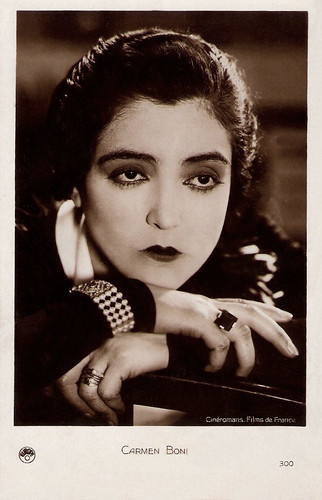
French postcard by Europe, no. 300. Photo: Cineromans / Films de France.

French postcard by Cinémagazine-Edition, no. 710. Photo: Sofar. Carmen Boni in the German late silent film Quartier Latin/Latin Quarter (Augusto Genina, 1929). Orplid-Film produced the film, Messtro-Film distributed it in Germany.
The European Clara Bow
Carmen Boni was born Maria Carmela Bonicatti in 1901 in Rome, Italy. She was the sister of cinematographer Mario Bonicatti. In 1919, she made her first film appearance under her own name for Nova Film in La pecorella/The Sheep (Pio Vanzi, 1920) with Ignazio Lupi. Then she played in the Italian silent drama Ave Maria (Memmo Genua, Diana Karenne, 1920). For this film, she was still credited with her birth name. Diana Karenne suggested she change her name, so enter Carmen Boni.
That year, the young actress also played leads in Miss Dorothy (Giulio Antamoro, 1920) with Lia Formia and Diana Karenne, Il fiore del Caucaso/The Flower of the Caucasus (Augusto Camerini, 1920), and Monella di strada/Monella Street (Umberto Fracchia, 1920) opposite Romano Calò. In the early 1920s, Boni had a successful career in Italian cinema. She worked with director Guglielmo Zorzi at La preda/The Prey (1921), La piccola ignota/The little unknown (1923), and Il riscatto/The Redemption (1924) opposite André Habay and Lido Manetti.
A success was the comedy La dama de Chez Maxim's (Amleto Palermi, 1923) in which she co-starred with Pina Menichelli. It is an adaptation of the 1899 play La Dame de chez Maxim by Georges Feydeau. With director Augusto Genina, she made La moglie bella/The beautiful wife (1924) with Ruggero Ruggeri, Il focolare spento/The hearth turned off (1925) with Lido Manetti, her international breakthrough L'ultimo lord/The last lord (1926) with Oreste Bilancia and Addio giovinezza!/Goodbye Youth (1927).
Addio giovinezza!/Goodbye Youth was adapted from the 1911 play of the same name by Nino Oxilia and Sandro Camasio. The film is set in Turin at the beginning of the Twentieth century, where a student (Walter Slezak) begins a romance with a seamstress Dorina (Boni). However, he is lured away by a sophisticated older woman (Elena Sangro) leaving Dorina distressed. Genina had previously directed an earlier version of the play in 1918. It was remade as a sound film of the same title in 1940.
These films were produced by Genina Film. Genina was both her Pygmalion and her husband. Together they moved to Germany when the Italian film industry got into a crisis in the mid-1920s and there were no possibilities anymore for Genina Film.

Finnish postcard by Kortcentralen/Korttikeskus, Helsingfors, no. 813, 1926. Photo: Marino, Roma.

Italian postcard by Ed. G.B. Falci, no. 480. Photo: Film Genina. Carmen Boni in L'ultimo lord/The last lord (Augusto Genina, 1926).

Italian postcard, no. 242. Card mailed in Italy in 1930. Photo: FotoEbung. Probably publicity still for L'ultimo lord/The last lord (Augusto Genina, 1926).
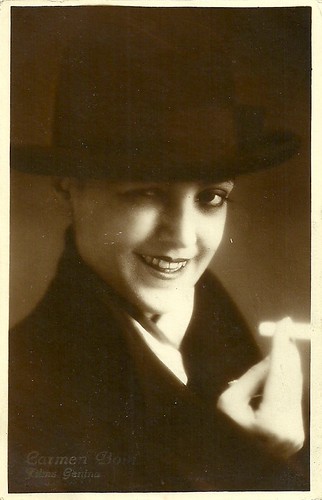
Italian postcard by G.B. Falci Ed., no. 688. Photo: Films Genina. Probably publicity still for L'ultimo lord/The last lord (Augusto Genina, 1926).

Austrian postcard by Iris Verlag, no. 953. Photo: Verleih Engel & Welter.

German postcard by Ross Verlag, no. 1783/1, 1927-1928. Photo: Arthur Ziehm, Berlin.
Suicide Attempt
Berlin was the European film capital at the time and Carmen Boni made one film after another during the late 1920s. Her German films include Venus im Frack/Venus in Tails (Robert Land, 1927) with Georg Alexander and Henri de Vries, Gehetzte Frauen (Richard Oswald, 1927) starring Asta Nielsen as Boni's mother, and Scampolo (Augusto Genina, 1928) in which she played a young Roman orphan. Reviewer Luke-28 at IMDb: "An unpretentious but amazingly witty little comedy, Scampolo confirms Genina's special 'touch': a mix of subtle irony and social satire akin to Lubitsch's own bittersweet vision of the world. Scampolo also serves as a perfect vehicle for Carmen Boni's verve and comic skills."
With her verve and comic skills, Boni managed to switch from big laughter to genuine emotion with uncommon natural ease. Carmen Boni had a modern type of beauty, and she became the European equivalent of Hollywood stars like Clara Bow, Colleen Moore and Louise Brooks. The last postcard in this post mentions the Karl Grune Film. This company only made one film with Carmen Boni: Katharina Knie (Karl Grune, 1929), based on the 1928 play of the same title by Carl Zuckmayer. Carmen Boni played the title role as the circus princess, with Eugen Klöpfer as her father. It was her last film in Germany.
After some more films in Italy, La Grazia/The Grace (Aldo De Benedetti, 1929), she moved to France where she performed in several Italian versions of Paramount films in the early 1930s, shot at the Paramount studios in Joinville. These films included the dramas Il richiamo del cuore/Appeal of the Heart (Jack Salvatori, 1930) and La vacanza del diavolo/The Devil's Holiday (Jack Salvatori, 1931).
In France, she also made with her husband the comedy La femme en home/The Woman Dressed As a Man (Augusto Genina, 1932) with Armand Bernard, and Ne sois pas jalousie/Don't be jealous (Augusto Genina, 1934). When Genina divorced her, she tried to commit suicide. Then she focused on other things instead of cinema. In 1938 she married the French actor Jean Rigaux.
She returned in only two more French films. The first was the Swashbuckler Le comte de Monte Cristo, 2ème époque: Le châtiment/The Count of Monte Christo, Part II (Robert Vernay, Ferrucio Cerio, 1943) featuring Pierre Richard-Willm, and based on the classic novel by Alexandre Dumas père. Her final film was D'Homme à homme/Man to Men (Christian-Jaque, 1948), about the founder of the Red Cross, Henri Dunant, played by Jean-Louis Barrault. In 1963 Carmen Boni was killed in Paris by a reckless car driver while crossing a zebra path. She was 62.
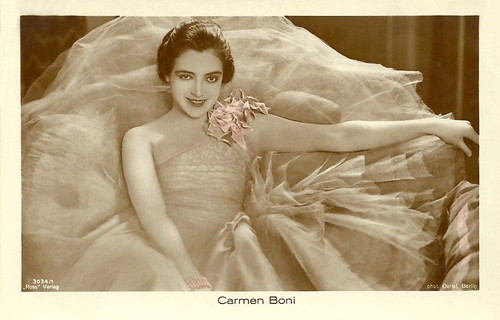
German postcard by Ross Verlag, no. 3034/1, 1928-1929. Photo: Oertel, Berlin.
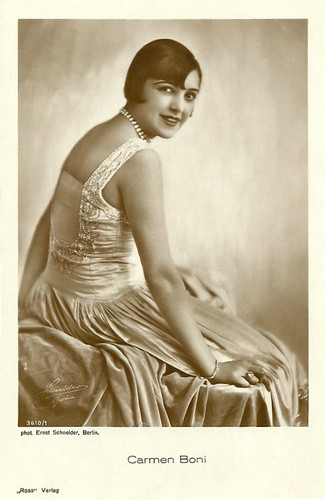
German postcard by Ross Verlag, no. 3610/1, 1928-1929. Photo: Ernst Schneider, Berlin.

German postcard by Ross Verlag, no. 3696/1, 1928-1929. Photo Lichtenstein, Berlin / Greenbaum Film.
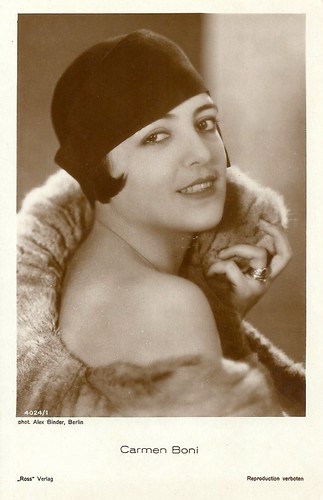
German postcard by Ross Verlag, no. 4024/1, 1929-1930. Photo: Alex Binder, Berlin.

German postcard by Ross Verlag, no. 4185/1, 1929-1930. Photo: Alex Binder, Berlin.
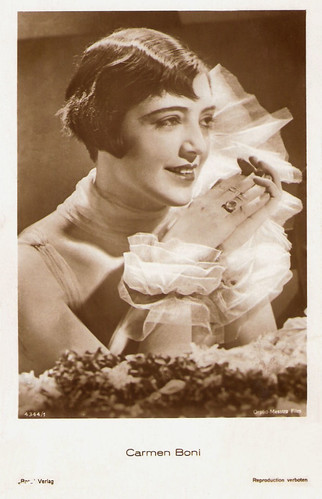
German postcard by Ross Verlag, no. 4344/1, 1929-1930. Photo: Orplid Messtro Film.

German postcard by Ross Verlag, no. 4920/1, 1929-1930. Photo: Atelier Gerstenberg.
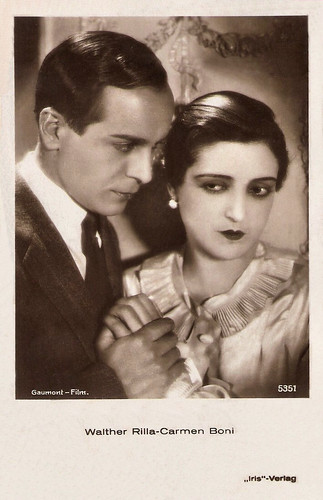
Austrian postcard by Iris-Verlag, no. 5351. Photo: Gaumont-Film. Publicity still for Prinzessin Olala/Princess Olala (Robert Land, 1928) with Walter Rilla.
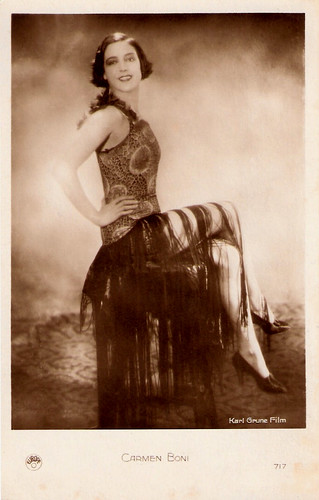
French postcard by Europe, no. 717. Photo: Karl Grune Film. Publicity still for Katharina Knie (Karl Grune, 1929).

French postcard by A.N. (A. Noyer, Paris), no. 875 Photo: Lipnitzki. The bottom part of the card was cut off, possibly to fit in an album.

French postcard. Photo: G.L. Manuel Frères. Collection: Didier Hanson.
Sources: Vittorio Martinelli (Le dive del silenzio - Italian), Luke-28 (IMDb), Wikipedia (English and Italian) and IMDb
This post was last updated on 14 June 2023.
No comments:
Post a Comment